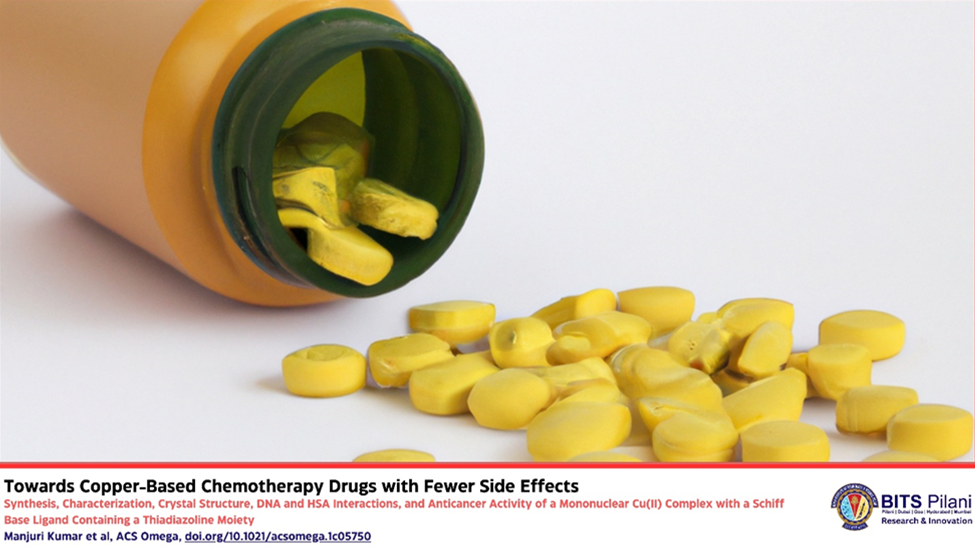Towards Copper-Based Chemotherapy Drugs with Fewer Side Effects
In 1965, biophysicists from the US made a serendipitous discovery that eventually led to a massive breakthrough in the field of cancer treatment. Dr. Barnett Rosenberg and his colleagues noticed that the E. coli bacteria would stop dividing when an electric current was applied to the culture medium. Initially, the researchers thought that electric fields could somehow control cell replication. However, after two years of trying to unveil the nature of this effect, they realized that it was not caused by electricity but by the platinum (Pt) electrodes used by them.
It turns out the electrodes leaked small amounts of a Pt-containing compound that could bind to DNA and interrupt cell replication. This molecule, which would later be named cisplatin, eventually rose to become the backbone of combinational treatment for various types of cancer.
Although the discovery of Pt-based metallodrugs for chemotherapy was a monumental achievement in medicine, these compounds still have notable drawbacks. In most cases, patients suffer from serious side effects, including kidney and nerve damage, as well as hearing loss. Moreover, cancer cells can become resistant to these drugs after long-term use, rendering them ineffective. But what if we could use a more bioessential element to develop next-generation anticancer metallodrugs?
In a recent study published in ACS Omega, a research team from the Birla Institute of Technology and Science-Pilani, including Sidhali U. Parsekar, Kumudini Paliwal, Paramita Haldar, and Associate Professor Manjuri Kumar, reported a novel copper (Cu) complex with much potential to serve as an anticancer agent. “Since Cu is an essential trace metal ion in our body, Cu(II) complexes containing suitable biologically relevant organic ligands, possessing biocompatible redox potential, and having high DNA binding propensity are likely to exhibit good biological activities, including the generation of reactive oxygen species (ROS), DNA cleavage, and anticancer properties,” explains Dr. Kumar.
The proposed molecule, which the researchers simply called “Complex 1,” is a mononuclear Cu(II) complex derived from a Schiff base with a thiadiazoline moiety. Through a series of detailed experiments, the team sought to shed light on its precise structure, DNA binding mechanisms, and biological activities.
Using several analytical techniques, including X-ray crystallography, spectral analysis, and cyclic voltammetry, the researchers established key details about the composition, atomic arrangement, and electrochemical stability of Complex 1. Interestingly, this molecule proved to be stable in solution at room temperature, an important consideration for clinical applications given the high costs of cold storage and cold transport.
Next, through fluorescence studies and circular DNA cleavage experiments, the team clarified the mechanisms via which Complex 1 bound to and cleaved DNA molecules. Unlike conventional metallodrugs, the proposed compound could cleave DNA not only through oxidative damage but also via hydrolysis, even without the addition of additional catalysts or reagents.
The researchers proceeded to investigate the anticancer effects of Complex 1 by examining its cytotoxicity in vitro against two well established malignant cell lines. Through 3-(4,5-dimethylthiazol-2-yl)-2,5-diphenyltetrazolium bromide (MTT) assays, the team quantified the proportion of cancer cells that were still metabolically active (i.e., viable) after applying different concentrations of the proposed metallodrug. More specifically, they calculated the half maximal inhibitory concentration (IC50) value for each strain, which indicates the drug concentration required to inhibit metabolic activity in 50% of the population. The results look very promising, as Dr. Kumar highlights: “The obtained IC50 values of 0.80 and 0.43 μM obtained from the MTT assays with HeLa and MCF7 cells, respectively, illustrates a remarkable in vitro anticancer activity of the proposed copper complex.”
Further analysis revealed the nature of the anticancer properties of Complex 1. A series of experiments confirmed that some of the cytotoxic effects observed by the researchers were due to an intracellular increase in ROS species, causing oxidative damage, cell cycle arrest, and subsequent cell death (apoptosis).
Another crucial aspect of anticancer drugs is their ability to reach and penetrate tumors efficiently and selectively. Ideally, these drugs would be “picked up” by natural carrier proteins in the bloodstream and distributed throughout the body, with a preferential accumulation in cancerous tissues. Thus, the team analyzed the binding of Complex 1 to the human serum albumin (HSA). “HSA in blood plasma is capable of reversibly binding metallodrugs and is selectively accumulated in tumor tissues, which enables selective delivery of drugs to target sites. Interaction studies with HSA are, therefore, regarded as vital in the development of anticancer agents,” explains Dr. Kumar.
Through fluorescence and electronic absorption spectroscopic experiments, the researchers shed light on the detailed interactions between Complex 1 and HSA, confirming a strong binding between them. This implies that the proposed metallodrug could benefit from enhanced stability and circulation in the body as well as selective delivery to tumor sites, minimizing side effects.
Together, the findings of this in-depth study reveal the untapped potential of copper-based complexes for the future development of chemotherapy drugs. With any luck, further efforts on this front will lead to safer, less expensive, and more effective anticancer therapies, giving humanity an edge against this terrible disease.
















